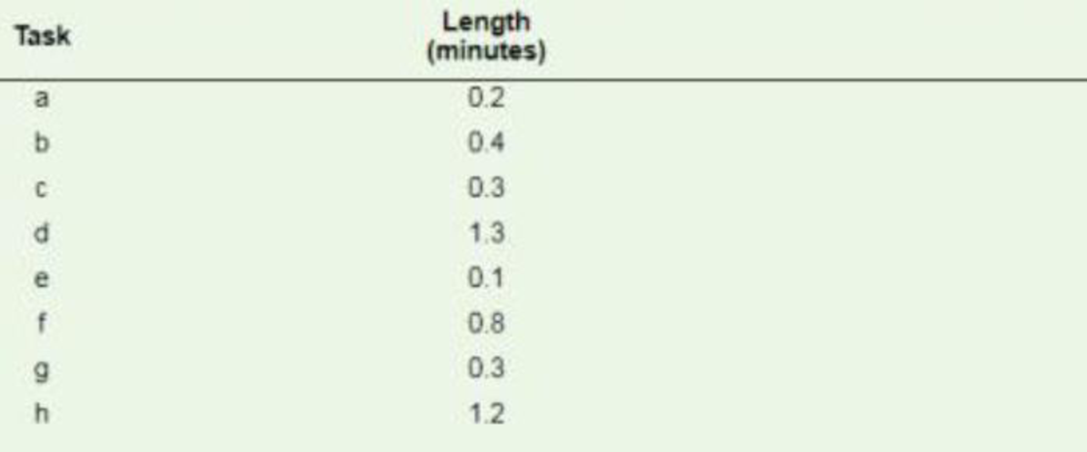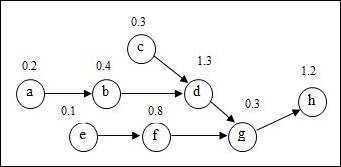
Concept explainers
A producer of inkjet printer is planning to add a new line of printers, and you have been asked to balance the process, given the following task time and precedence relationship. Assume that cycle time is to be the minimum possible.

a. Do each of the following:
(1) Draw the precedence diagram.
(2) Assign tasks to stations in order of most following tasks. Tiebreaker, greatest positional weight.
(3) Determine the percentage of idle time.
(4) Compute the late of output in printers per day that could be expected for that line assuming a 420-minute working day.
b. Answer these questions:
(1) What it the shortest cycle tone that will permit use of only two workstations? Is this cycle time feasible? Identify the tasks you would assign to each station.
(2) Determine the percentage of idle time that would results if two stations were used.
(3) What is the daily output under this arrangement?
(4) Determine the output rate that would be associated with the maximum cycle time.
a) 1
To draw: The precedence diagram.
Answer to Problem 4P
Answer: Precedence diagram:

Explanation of Solution
Given information:
| Task | Length (minutes) | Immediate (Predecessor) |
| a | 0.2 | Nil |
| b | 0.4 | a |
| c | 0.3 | Nil |
| d | 1.3 | b, c |
| e | 0.1 | Nil |
| f | 0.8 | e |
| g | 0.3 | d, f |
| h | 1.2 | g |
Precedence diagram:

The precedence diagram is drawn circles and arrows. The tasks are represented in circles and weights for each task are represented outside the circle. The arrows are represented to show which task is preceding the other task and so on.
2)
To assign: Tasks to workstations in the order of most following tasks.
Explanation of Solution
Given information:
| Task | Length (minutes) | Immediate (Predecessor) |
| a | 0.2 | Nil |
| b | 0.4 | a |
| c | 0.3 | Nil |
| d | 1.3 | b, c |
| e | 0.1 | Nil |
| f | 0.8 | e |
| g | 0.3 | d, f |
| h | 1.2 | g |
The positional weight of a task is the sum of the task times of the task itself and all of the following tasks.
| Task | Following tasks | Number of following tasks | Calculation of positional weight | Positional weight |
| a | b, d, g, h | 4 | 0.2 + 0.4 + 1.3 + 0.3 + 1.2 | 3.4 |
| b | d, g, h | 3 | 0.4 + 1.3 + 0.3 + 1.2 | 3.2 |
| c | d, g, h | 3 | 0.3 + 1.3 + 0.3 + 1.2 | 3.1 |
| d | g, h | 2 | 1.3 + 0.3 + 1.2 | 2.8 |
| e | f, g, h | 3 | 0.1 + 0.8 + 0.3 + 1.2 | 2.4 |
| f | g, h | 2 | 0.8 + 0.3 + 1.2 | 2.3 |
| g | h | 1 | 0.3 + 1.2 | 1.5 |
| h | Nil | 0 | 1.2 | 1.2 |
Calculation of cycle time:
The cycle is said to be the minimum time possible.
Therefore, the cycle time is 1.3 minutes / unit.
Assigning tasks to workstations:
| Workstation number | Eligible task | Assigned task | Task time | Unassigned cycle time | Reason |
| 1.3 | |||||
| 1 | a, c, e | a | 0.2 | 1.1 | Task 'a' has more number of following tasks |
| b, c , e | b | 0.4 | 0.7 | Task 'b' has greatest positional weight | |
| c, e | c | 0.3 | 0.4 | Task 'c' has greatest positional weight | |
| d, e | e | 0.1 | 0.3 | Task 'e' has greatest positional weight | |
| d, f | None | 0.3 (Idle time) | The task time is greater than the unassigned cycle time. | ||
| 1.3 | |||||
| 2 | d, f | d | 1.3 | 0 | Task 'd' has greatest positional weight |
| 1.3 | |||||
| 3 | f | f | 0.8 | 0.5 | Task 'f' is the only eligible task available |
| g | g | 0.3 | 0.2 | Task 'g' is the only eligible task available | |
| h | None | 0.2 (Idle time) | The task time is greater than the unassigned cycle time. | ||
| 1.3 | |||||
| 4 | h | h | 1.2 | 0.1 | Task 'h' is the only task remaining |
| 0.1 (Idle time) | All tasks completed |
Overview of tasks assignment:
| Workstation | Assigned tasks | Total cycle time used | Idle time |
| 1 | a, b, c, e | 1 | 0.3 |
| 2 | d | 1.3 | 0 |
| 3 | f, g | 1.1 | 0.2 |
| 4 | h | 1.2 | 0.1 |
3)
To determine: The percentage of idle time.
Answer to Problem 4P
Explanation of Solution
Formula to calculate percentage of idle time:
Calculation of percentage of idle time:
The percentage of idle time is 11.54%.
4)
To determine: The rate of output printers per day.
Answer to Problem 4P
Explanation of Solution
Given information:
Operating time per day = 420 minutes
Formula to calculate output printers per day:
Calculation of output printers per day:
The rate of output printers per day is 323.08 printers / day.
b) 1
To determine: The shortest cycle time that will permit the use of only 2 workstations and to check if it is feasible.
Explanation of Solution
Given information:
| Task | Length (minutes) | Immediate (Predecessor) |
| a | 0.2 | Nil |
| b | 0.4 | a |
| c | 0.3 | Nil |
| d | 1.3 | b, c |
| e | 0.1 | Nil |
| f | 0.8 | e |
| g | 0.3 | d, f |
| h | 1.2 | g |
Calculation of shortest cycle time:
The shortest cycle time is calculated by summing all the task times and dividing the resultant value by 2 workstations.
The obtained shortest cycle time is feasible based on the task times. Every task time is either equal to or less than 2.3 minutes. The feasibility is checked by assigning the tasks to the 2 workstations.
Assigning tasks to workstations:
| Workstation number | Eligible task | Assigned task | Task time | Unassigned cycle time | Reason |
| 2.3 | |||||
| 1 | a, c, e | a | 0.2 | 2.1 | Task 'a' has more number of following tasks |
| b, c , e | b | 0.4 | 1.7 | Task 'b' has greatest positional weight | |
| c, e | c | 0.3 | 1.4 | Task 'c' has greatest positional weight | |
| d, e | e | 0.1 | 1.3 | Task 'e' has more number of following tasks | |
| d, f | d | 1.3 | 0 | Task 'd' has greatest positional weight | |
| 2.3 | |||||
| 2 | f | f | 0.8 | 1.5 | Task 'f' is the only eligible task available |
| g | g | 0.3 | 1.2 | Task 'g' is the only eligible task available | |
| h | h | 1.2 | 1.2 | Task 'h' is the only task available |
Overview of tasks assignment:
| Workstation | Assigned tasks | Total cycle time used | Idle time |
| 1 | a, b, c, e, d | 2.3 | 0 |
| 2 | f, g, h | 2.3 | 0 |
The shortest cycle time of 2.3 minutes is feasible.
2)
To determine: The percentage of idle time.
Answer to Problem 4P
Explanation of Solution
Formula to calculate percentage of idle time:
Calculation of percentage of idle time:
The percentage of idle time is 0.00%.
3)
To determine: The daily output under this arrangement.
Answer to Problem 4P
Explanation of Solution
Given information:
Operating time per day = 420 minutes
Formula to calculate output under this arrangement:
Calculation of output under this arrangement:
The rate of output under this arrangement is 182.61 units / day.
4)
To determine: The output rate associated with cycle time.
Answer to Problem 4P
Explanation of Solution
Given information:
Operating time per day = 420 minutes
Formula to calculate output under this arrangement:
Calculation of output under this arrangement:
The maximum cycle time is the sum of all task times.
The sum of all task times is:
The rate of output under this arrangement is 91.30 units / day.
Want to see more full solutions like this?
Chapter 6 Solutions
Operations Management
- 5. Flo's Quick-Lube performs fast oil changes (A) and checks for tire pressure and wear (B) and brakes and alignment (C) according to the process flow indicated by the diagram below. Each incoming car is put on a jack while one technician performs task A and another simultaneously performs task B and a third performs task C (which must follow task B due to the limited space under the vehicle on the jack). The server for task A takes on average 3 minutes to process a job, the server for task B takes on average 2 minutes to process a job, and the server for task C takes on average 2 minutes to process a job. Server A can be operated in parallel with Servers B and C. All processing times are random and exponentially distributed, and jobs are allowed to queue in front of each server. (You can assume that the number of jacks is sufficient to allow any length of queue.) (a) AND B A C Figure 1: Flo's Process Flow What is the capacity of the process (in orders/minute)?arrow_forwardSue Helms Appliances wants to establish an assem-bly line to manufacture its new product, the Micro Popcorn Popper. The goal is to produce five poppers per hour. The tasks,task times, and immediate predecessors for producing one MicroPopcorn Popper are as follows:TASK TIME (min) IMMEDIATEPREDECESSORSA 10 —B 12 AC 8 A, BD 6 B, CE 6 CF 6 D, Ea) What is the theoretical minimum for the smallest number ofworkstations that Helms can achieve in this assembly line?b) Graph the assembly line, and assign workers to workstations.Can you assign them with the theoretical minimum?c) What is the efficiency of your assignment?arrow_forwardConsider the following three-station production line with a single product that must visit stations 1, 2, and 3 in sequence: a) Calculate the bottleneck rate, the raw process time, and the critical WIP. Bottleneck rate (Provide to 3 decimals): Raw process time b) Critical WIP: (Provide to 2 decimalsarrow_forward
- A small assembly line for the assembly of power steering pumps needs to be balanced. Precedence diagram is shown below. The cycle time is determined to be 1.7 minutes. How would the line be balanced by choosing the assignable task having the longest task time first? Fill in the table below. If your answer is zero, enter "0". Round your answers to one decimal place. Station Tasks Total Time Idle Time 1 B,A,C,D 2 E,F 3 G,H,I Total What is the assembly-line efficiency? Round your answer to one decimal place. %arrow_forwardAs the Cottrell Bicycle Co. of St. Louis completes plans for its new assembly line, it identifies 25 different tasksin the production process. VP of Operations Jonathan Cottrell now faces the job of balancing the line. He lists precedencesand provides time estimates for each step based on work-sampling techniques. His goal is to produce 1,000 bicycles perstandard 40-hour workweek.Balance this operation using the shortest operation time rule and compute the efficiency of the line.arrow_forwardA company is setting up an assembly line to produce 90 units per hour. The table below identifies the work elements, times, and immediate predecessors. Work Element Time (Sec.) Immediate Predecessor(s) A 25 - B 18 A C 20 A D 5 B, C E 12 C F 8 E G 16 D, F H 12 G What cycle time is required to satisfy the required output? What is the theoretical minimum number of stations?arrow_forward
- The tasks shown in the following precedence diagram are to be assigned to workstations with theintent of minimizing idle time. Management has designed an output rate of 275 units per day. Assume440 minutes are available per day.a. Determine the appropriate cycle time.b. What is the minimum number of stations possible?arrow_forwardb. In order of greatest positional weight. Tiebreaker: most following tasks. (Use your rounded cycle time. Enter your tasks in the order they were assigned at each station as a letter between a and h in lowercase with no other text or symbols. Round your numerical answers to 1 decimal place.) Time Work Station Task Task Time Remaining II II IV What is Efficiency? (Use your rounded cycle time in the denominator of your efficiency calculation. Round your answer to 1 decimal place.) Efficiency %arrow_forwardGiven the following information, assign tasks to work stations using the most followers rule. Assume the cycle time is 60 seconds and the minimum number of workstations is 3. Submit for each workstation (1,2,3,4 etc.), the tasks assigned in order of assignment, the idle time for each work station and the total idle time. (It will help for you to make the diagram but you are not required to submit the diagram) Task A D w Immediate Predecessor D CE Task Time (seconds) 35 50 20 10 25 40arrow_forward
- Three departments- milling (M), drilling (D), andsawing (S)- are assigned to three work areas in Victor Berardis'smachine shop in Kent, Ohio. The number of workpieces movedper day and the distances between the centers of the work areas,in feet, follow. Pieces Moved between Work Areas Each Day lt costs $2 to move I workpiece I foot.What is the cost?arrow_forwardArrange the eight departments shown in the accompanying Muther grid into a 2 × 4 format. Note: Department 1 must be in the location shown.arrow_forwardA Manufacturing Corp. with three-station work cell has the process displayed below. Each workstation has only one worker to the assigned activity. Single order arrives every 7.5 hours. c) What is the cycle time corresponding to maximum throughput and actual throughput?d) Suppose that a second parallel machine is added at station 2. What is the new bottleneck timeand new throughput time of the system? How did the addition of the second machine at workstation 2 affect the performance of the work cell?arrow_forward
 Practical Management ScienceOperations ManagementISBN:9781337406659Author:WINSTON, Wayne L.Publisher:Cengage,
Practical Management ScienceOperations ManagementISBN:9781337406659Author:WINSTON, Wayne L.Publisher:Cengage,
